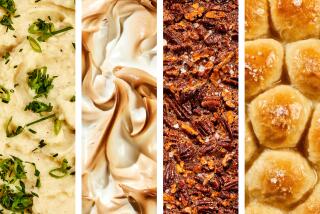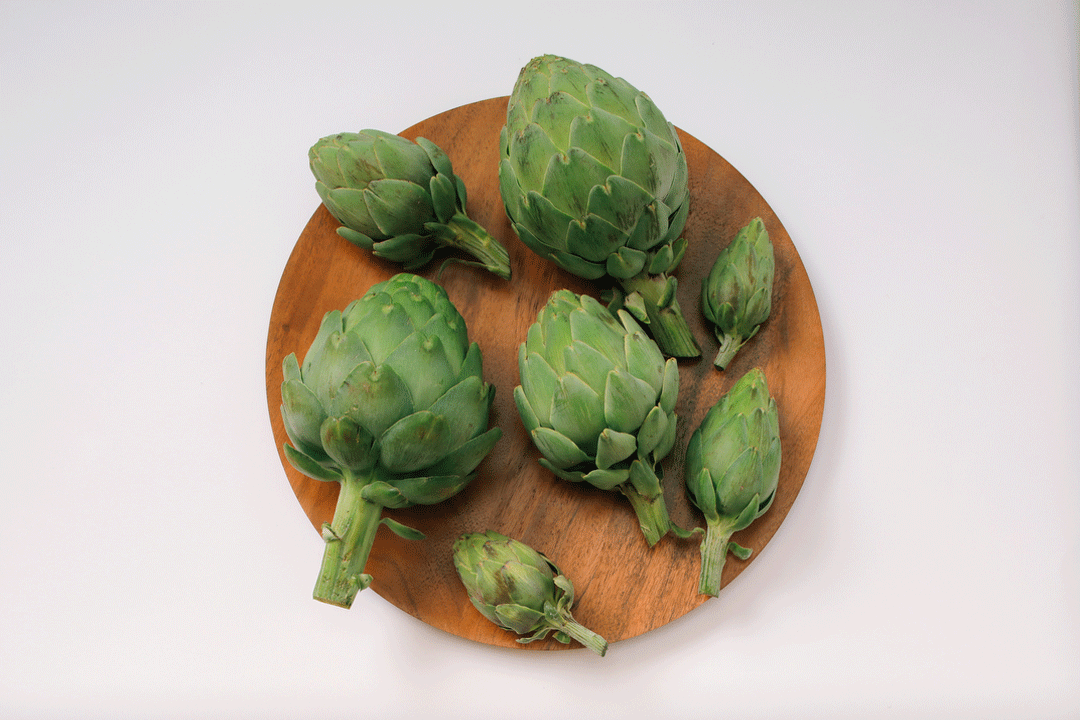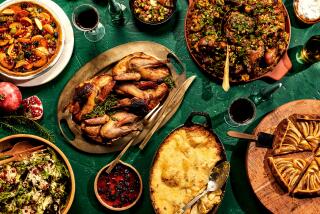Thanksgiving Handbook : Beyond the Ultimate Turkey
- Share via
Americans spend a lot of time and money on their Thanksgiving turkeys. So why do so many holiday birds come out dry and tasteless? It’s gotten to the point that some families think that turkey is supposed to taste bland, essentially a conduit for gravy and cranberry sauce.
But there is a better way. Last year, the Times Food Section introduced the Ultimate Turkey, made using a roasting method that turns out an amazingly moist bird. Even the breast meat stays tender--and it tastes like something you really want to eat, gravy or not.
Here’s the basic idea: Instead of stuffing the bird’s body cavity as usual, loosen the skin of the turkey and place the stuffing under the skin. The layer of stuffing makes the skin crisp and delicious, and helps keep the breast meat moist--the heat is able to circulate within as well as around the bird, helping the turkey cook faster.
There is also a radical change in cooking times. Instead of cooking the turkey to the normally recommended internal temperature of 185 degrees (an old U.S. Department of Agriculture standard that gives cooks an extra cushion of safety--and, usually, dried-out meat), we recommended taking turkey out of the oven when the internal temperature of the meat reaches 155 degrees to 160 degrees.
This, along with the unstuffed body cavity, means instead of cooking turkey 18 to 24 minutes a pound, you can leave it in the oven just 7 to 9 minutes per pound. A 12-pound turkey, with stuffing, could be done in just a little more than 90 minutes.
Of course, this method is not without controversy. Lots of readers wrote in last year that we’d saved their Thanksgiving--never had they eaten a more delicious turkey. A few, however, were frankly irate. Their turkeys had not cooked all the way through, especially in areas near the joints. Their main concern: Is it really safe to cook a turkey just 7 to 9 minutes a pound?
*
A USDA food safety expert told The Times that food-borne bacteria are considered dead when the internal temperature of a piece of meat reaches 147 degrees. A USDA advisory recording plays it a little safer, saying that turkey is considered safe to eat when the internal temperature taken at the thickest part of the thigh reaches 160 degrees and the stuffing reaches 165 degrees.
When you consider that turkey will continue cooking after it’s removed from the oven--the standard estimate is an additional 10 degrees--cooking a turkey to an internal temperature of 185 degrees begins to seem unnecessary. A temperature of 150 degrees would be a safe minimum, though in our recipe we call for the bird to be cooked to an internal temperature of 155 degrees to 160 degrees. After it’s removed from the oven and sits out 20 minutes or so, its internal temperature will probably have risen to 165 degrees to 170 degrees.
Last year, The Times Test Kitchen roasted dozens of turkeys, trying to anticipate different oven types and individual cooking styles. And most people we heard from had no problem getting their turkeys to cook properly.
Of course, with any new method, there are bound to be a few kinks to work out, and in examining the complaints that came in, we found a few common problems. One thing is vital if you’re going to rely on the 7 to 9 minutes per pound cooking time: The turkey must be completely thawed before it’s put in the oven. We recommend using fresh turkey, which can be ordered ahead from most supermarkets. But remember, even fresh turkey can arrive with ice-hardened joints and will probably need some thawing.
One suggestion The Times Test Kitchen came up with in this year’s trials: Don’t truss the bird. Not trussing will let the oven heat reach the inner joints more easily. And don’t tuck the wings under the bird, for the same reason.
*
If you still find a few red spots at the joints when you begin to carve the turkey, don’t panic . Remove the thighs and wings, then and place them in a pan and tent with foil (uncovered, the meat can dry out in five minutes). Warm the meat in the oven at 350 degrees for about 10 minutes.
As soon as you put the meat in the oven, go back to carving the rest of the turkey. By the time you finish carving and distributing the breast meat--which should be delicious and tender--the parts in the oven should be completely cooked.
Finally, we understand that traditions are hard to break. And so, we offer instructions on the making of an old-fashioned basic roast turkey in the story “Trial by Turkey” below.
THE ULTIMATE TURKEY
1 (12- to 13-pound) fresh or completely thawed turkey
Salt, pepper
4 cups stuffing, about
1 stalk celery, cut into thirds
1 carrot, cut into thirds
1 small onion
Melted butter
Thaw turkey thoroughly. Even fresh turkeys normally have icy sections and must be thawed.
Rinse turkey inside and out. Pat dry. Season whole bird to taste with salt and pepper.
Run fingers carefully between skin and flesh of turkey, loosening skin. Working slowly, push stuffing in thin layer under breast and thigh of turkey. Put celery, carrot and onion into body cavity of turkey.
Put turkey in large roasting pan, breast side up. Do not truss bird and do not tuck wings under bird. Brush turkey with melted butter. Roast at 350 degrees 7 to 9 minutes per pound, or until turkey registers 155 to 160 degrees when thermometer is placed deep into both breast and thigh, nearest bone.
Remove from oven and let stand 20 minutes before carving. Makes 12 to 13 servings.
More to Read
Eat your way across L.A.
Get our weekly Tasting Notes newsletter for reviews, news and more.
You may occasionally receive promotional content from the Los Angeles Times.









